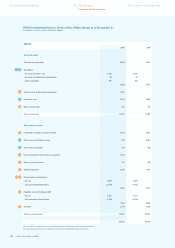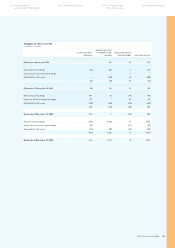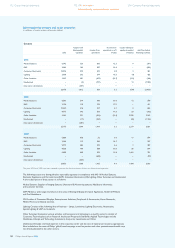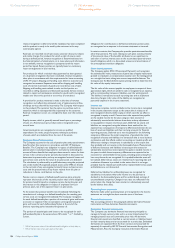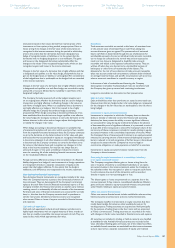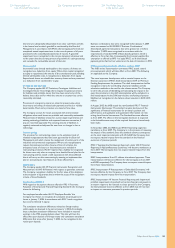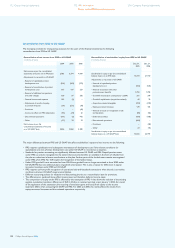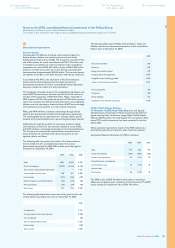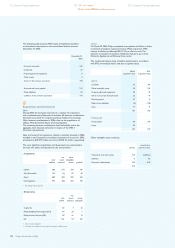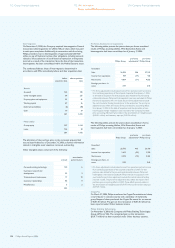Philips 2006 Annual Report Download - page 185
Download and view the complete annual report
Please find page 185 of the 2006 Philips annual report below. You can navigate through the pages in the report by either clicking on the pages listed below, or by using the keyword search tool below to find specific information within the annual report.
Philips Annual Report 2006 185
The consolidated fi nancial statements in this section have been prepared
in accordance with International Financial Reporting Standards (IFRS)
as adopted by the European Union. For the Company, this is materially
the same as IFRS as adopted by the International Accounting
Standards Board (IASB). IFRS include both IFRS and International
Accounting Standards (IAS).
The Company presented consolidated fi nancial statements under IFRS
for the fi rst time in the Annual Report 2005.
Historical cost is used as the measurement basis unless otherwise
indicated.
Consolidation principles
The consolidated fi nancial statements include the accounts of
Koninklijke Philips Electronics N.V. (‘the Company’ or ‘Philips’) and
all subsidiaries that fall under its power to govern the fi nancial and
operating policies of an entity so as to obtain benefi ts from its
activities. The Company applies IAS 27 ‘Consolidated and Separate
Financial Statements’ and Interpretation SIC 12 ‘Consolidation –
Special Purpose Entities’. All intercompany balances and transactions
have been eliminated in the consolidated fi nancial statements.
The minority interests are disclosed separately in the consolidated
statements of income as part of profi t allocation and in the
consolidated balance sheets as a separate component of equity.
Foreign currencies
The fi nancial statements of entities that use a functional currency
other than the euro, are translated into euros. Assets and liabilities are
translated using the exchange rates on the respective balance sheet
dates. Income and expense items in the income statement and cash
fl ow statement are translated to euros at exchange rates at the dates
of the transaction. The resulting translation adjustments are recorded
as a separate component of equity. Cumulative translation adjustments
are recognized as income or expense upon partial or complete disposal
or substantially complete liquidation of a foreign entity. The functional
currency of foreign entities is generally the local currency, unless the
primary economic environment requires the use of another currency.
Gains and losses arising from the translation or settlement of foreign
currency-denominated monetary assets and liabilities into the local
currency are recognized in income in the period in which they arise.
However, currency differences on intercompany loans that have the
nature of a permanent investment are accounted for as translation
differences as a separate component of equity.
Use of estimates
The preparation of fi nancial statements requires management to
make estimates and assumptions that affect amounts reported in the
consolidated fi nancial statements in order to conform to IFRS. These
estimates and assumptions affect the reported amounts of assets and
liabilities, the disclosure of contingent liabilities at the date of the
consolidated fi nancial statements, and the reported amounts of
revenues and expenses during the reporting period. We evaluate these
estimates and judgements on an ongoing basis and base our estimates
on experience, current and expected future conditions, third-party
evaluations and various other assumptions that we believe are
reasonable under the circumstances. The results of these estimates
form the basis for making judgements about the carrying values of
assets and liabilities as well as identifying and assessing the accounting
treatment with respect to commitments and contingencies. Actual
results could differ from the estimates and assumptions.
Estimates signifi cantly impact goodwill and other intangibles acquired,
tax on activities disposed, impairments, liabilities from employee benefi t
plans, other provisions and tax and other contingencies. The fair values
of acquired identifi able intangibles are based on an assessment of
future cash fl ows. Impairment analyses of goodwill and indefi nite-lived
intangible assets are performed annually and whenever a triggering
event has occurred to determine whether the carrying value exceeds
the recoverable amount. These analyses are based on estimates of
future cash fl ows.
Assumptions used to determine pension liabilities include the interest
rate and discount rate. In the Risk management section in the annual
report, a sensitivity analysis of these factors is presented.
Accounting changes
The Company applies the retrospective method for reporting a change
in accounting principle in the absence of explicit transition requirements
for new accounting pronouncements.
Reclassifi cations
Certain items previously reported under specifi c fi nancial statement
captions have been reclassifi ed to conform with the 2006 presentation.
The line item ‘Investments in unconsolidated companies’ was renamed
‘Investments in equity-accounted investees’ to improve the
relationships between line items and accounting policies. Investments
accounted for at cost have been reclassifi ed to Other non-current
fi nancial assets.
Discontinued operations and non-current assets held for sale
Based on IFRS 5 ‘Non-current Assets Held for Sale and Discontinued
Operations’, the Company has determined its cash-generating units as
components of an entity for the purpose of assessing whether or not
operations and cash fl ows can be clearly distinguished from the rest
of the Company, in order to qualify as a discontinued operation in
the event of disposal of the component. In compliance with IFRS 5,
non-current assets held for sale and discontinued operations are
carried at the lower of carrying amount and fair value less costs to
sell. Any gain or loss from disposal of a business, together with the
results of these operations until the date of disposal, is reported
separately as discontinued operations in accordance with IFRS 5. The
fi nancial information of discontinued operations is excluded from the
respective captions in the consolidated fi nancial statements and
related notes.
Cash fl ow statements
Cash fl ow statements have been prepared using the indirect method
in accordance with the requirements of IAS 7 ‘Cash Flow Statements’.
Cash fl ows in foreign currencies have been translated into euros using
the exchange rate at the time of the transaction. Cash fl ows from
derivative instruments that are accounted for as fair value hedges or
cash fl ow hedges are classifi ed in the same category as the cash fl ows
from the hedged items. Cash fl ows from other derivative instruments
are classifi ed consistent with the nature of the instrument.
Earnings per share
The Company presents basic and diluted earnings per share (EPS) data
for its common shares. Basic EPS is calculated by dividing the profi t
attributable to common shareholders of the Company by the weighted
average number of common shares outstanding during the period.
Diluted EPS is determined by adjusting the profi t or loss attributable
to common shareholders and the weighted average number of
common shares outstanding for the effects of all dilutive potential
common shares, which comprise convertible personnel debentures,
restricted shares and share options granted to employees.
Revenue recognition
The Company recognizes revenue, in accordance with IAS 18 ‘Revenue’,
when persuasive evidence of an arrangement exists, delivery has
occurred or the service has been provided, the sales price is fi xed or
determinable, and collectibility is reasonably assured. For consumer-
type products in the segments Lighting, DAP and Consumer Electronics,
these criteria are generally met at the time the product is shipped and
delivered to the customer and, depending on the delivery conditions,
title and risk have passed to the customer and acceptance of the
product, when contractually required, has been obtained, or, in cases
where such acceptance is not contractually required, when management
has established that all aforementioned conditions for revenue
recognition have been met and no further post-shipment obligations
exist. Examples of the above-mentioned delivery conditions are ‘Free
on Board point of delivery’ and ‘Costs, Insurance Paid point of delivery’,
where the point of delivery may be the shipping warehouse or any
other point of destination as agreed in the contract with the customer
and where title and risk in the goods pass to the customer.
Revenues of transactions that have separately identifi able components
are recognized based on their relative fair values. These transactions
mainly occur in the Medical Systems segment for arrangements that
require subsequent installation and training activities in order to become
operable for the customer. However, since payment for the equipment
is typically contingent upon the completion of the installation process,
IFRS accounting policies
226 Corporate governance224 Reconciliation of
non-US GAAP information
234 The Philips Group
in the last ten years
236 Investor information



